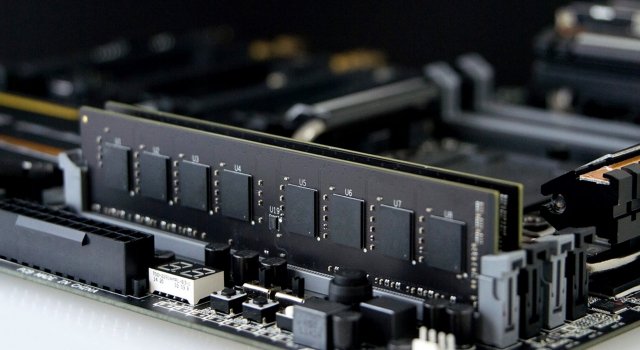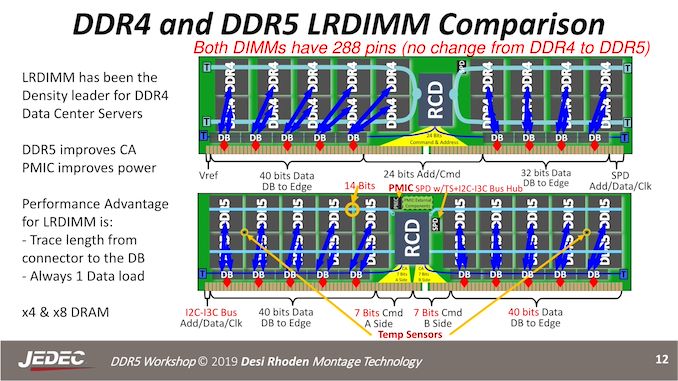TeamGroup Announces Intentions for DDR5, ELITE DDR5-5200 in 2021
by Gavin Bonshor on December 1, 2020 1:00 PM EST
Earlier in the year, we learned that a lot of DDR5 manufacturing is already in the pipeline, with Samsung, SK Hynix, and Micron all making announcements this year regarding their respective DDR5 plans. All of this speculation points to a 2021 launch, and to our surprise one of the module manufacurers is leading a charge. TeamGroup today is making an official statement revealing its plans to launch its ELITE series product lines, starting with DDR5-4800 modules and moving up to DDR5-5200.
Since the official specifications of DDR5 have been published by JEDEC, the initial standards include DDR5-3200 all the way to DDR5-6400, with future standards of up to DDR5-8400 expected. However, the full specifications haven't been unveiled. In October, we examined information on sub-timings and latency with DDR5, and we also saw SK Hynix's announcement of its DDR5-4800 memory.
TeamGroup is a module manufacturer, and it has signaled its intentions to manufacture its first DDR5 under its popular ELITE series. The TeamGroup ELITE DDR5 series will first be available in 16 GB DDR5-4800 modules, with an operating voltage of 1.1 V, which is down from 1.2 V compared to the previous generations. TeamGroup states that this is an increase of up to 1.6 times the performance compared to its current memory (4800/3000 = 1.6), reducing 10% in power consumption. However, it doesn't specify whose DDR5 chip it will use, although this is likely to be unveiled at a later date.
As we know from the official DDR5 specifications, each module will include on-die ECC for cell-to-cell data coherence (module-wide ECC is still optional). There are also two channels on each DDR5 memory stick. This is similar to LPDDR4 and GDDR6, with DDR5 opting for two independent 40-bit channels per module. These will still be based on the 288 pin design as DDR4 but will include different pinouts and notches/keying.
It looks as though TeamGroup is in full control of its expected DDR5 launch, which they state is likely to be in Q3 2021. It hasn't provided specific details about its ELITE DDR5 series, but there is a lot of time between now and the third quarter of next year, and we expect to hear much more information sometime within the next few months. The fact that ELITE is a consumer brand suggests that TeamGroup knows we will be seeing a consumer-grade processor around that time with DDR4, but ELITE is also the base bare-PCB variant, which might be focused more to base enterprise models instead.
Related Reading
- Insights into DDR5 Sub-timings and Latencies
- DDR5 is Coming: First 64GB DDR5-4800 Modules from SK Hynix
- DDR5 Memory Specification Released: Setting the Stage for DDR5-6400 And Beyond
- SK Hynix: We're Planning for DDR5-8400 at 1.1 Volts
- Cadence DDR5 UpdateL Launching at 4800 MT/s, Over 12 DDR5 SoCs in Development
Source: TeamGroup











19 Comments
View All Comments
TheinsanegamerN - Tuesday, December 1, 2020 - link
Next gen 7/5nm APUs with DDR5 are going to be bomb.FreckledTrout - Friday, December 4, 2020 - link
Yup. When AMD is on TSMC's 2nm using gaafet transistors we should see some insane APU's. I wouldn't doubt at that point we see some on die HBM as well.rickon66 - Tuesday, December 1, 2020 - link
It is about time, I've been waiting to build a new PC until DDR5 is available. Maybe by that time I can lay my hands on a RTX 3080Ti also.Rudde - Wednesday, December 2, 2020 - link
Intel has announced that their next server lineup (Sapphire Rapids) will support DDR5. On the consumer side we should see Alder Lake with DDR5 support. It has been widely rumoured that AMDs next desktop platform would use DDR5 (in addition to DDR4). Everything points to a second half of 2021, or early 2022, launch for those platforms.As for the 3080Ti, I'd imagine them going with 3080 super as in last generation, as 3060Ti hits the stores today. Then again, there have been rumors of a 3080Ti with double the memory (16Gb (2GB) instead of 8Gb (1GB) modules).
TomWomack - Wednesday, December 2, 2020 - link
Is it reasonable to expect a late-2021 HEDT which is to Sapphire Rapids what Skylake-X was to Skylake-SP? Alder Lake doesn't look like a desktop platform - I don't see the point in big/little on a system that plugs into the wall - but I have the impression that laptops which take memory modules rather than having RAM soldered to the motherboard are getting to be the exception.(I note that Elite are saying 'module' rather than 'DIMM' or 'SODIMM' - will DDR5 continue to have that distinction?)
Santoval - Thursday, December 3, 2020 - link
"Alder Lake doesn't look like a desktop platform - I don't see the point in big/little on a system that plugs into the wall.."Alder Lake-S is going to have a TDP of 125W, so it *is* a desktop CPU, exclusively. One of the reasons Intel moved to a big.LITTLE design is to compete in energy efficiency with that scheme because they cannot compete in process node efficiency. Remember, Alder Lake-S is largely set to be targeted against Zen 4, not Zen 3 (it might be released a couple of months earlier than Zen 4, at the earliest).
Even if the energy efficiency of the last iteration of Intel's 10nm process node is going to be equivalent to TSMC's non-EUV 7nm node (it might be; TSMC's partly EUV based 7nm+ node is both denser and surely more efficient but that is not the node Zen 3 is fabbed with) it is still going to be far less efficient than TSMC's 5nm node that Zen 4 will be fabbed with.
Therefore, a big.LITTLE scheme is a nice way to increase the energy efficiency of your SoC and perhaps save power from the little cores to clock the big cores and the iGPU faster while also making nice marketing claims that you have the "most energy efficient desktop CPU" ;-)
The drawback is that since the little cores do not have AVX-512 the big cores need to have it disabled so that they maintain feature parity (as Lakefield already showed; look up the Lakefield review here in AnandTech). In fact the Gracemont cores are going to be very first little cores of Intel with AVX2. If they didn't the Golden Cove cores couldn't use AVX2 either, so both Zen 3 and Zen 4 CPUs would decimate them in floating point performance! Is is a safe bet that Intel added AVX2 to Gracemont, thus making it somewhat bigger, due to Alder Lake.
Santoval - Thursday, December 3, 2020 - link
p.s. The big irony is that Alder Lake will remove AVX-512 support right when its Zen 4 competitor introduces it!scineram - Wednesday, December 2, 2020 - link
Obviously AMD will not support both on the same socket.Santoval - Thursday, December 3, 2020 - link
Zen 4 will most likely be released in Q1 2022. It will be released a bit later than usual due to a mid-2021 Zen 3 refresh that is widely expected and due to expected extra delays from the switch to a new platform and the testing and validation that will require. The refresh will be based on the same platform and socket (and will probably just offer a bit higher clocks, nothing more), but Zen 4 will require a brand new platform, a brand new socket (AM5), almost certainly DDR5 and potentially will also switch to PCIe 5.0 - perhaps alongside PCIe 4.0Tomatotech - Wednesday, December 2, 2020 - link
Looks like Apple will be using DDR5 in their Apple Silicon MacBook Pro 16” that’s rumoured to be coming out right around that timescale (summer 2021). A little bit early for DDR5 but Apple are masters at getting their hands early on new tech.Should be a beast of a laptop, rumoured to have 8 performance cores & 4 low power (against the current 4+4 M1). 10% lower power consumption will be big for Apple too.
Probably cost a fortune too but DDR5 will help differentiate it from the Air. AnandTech said a single core on the M1 is able to almost saturate the memory controller & get 60 GB/s (Intel and AMD only get 30GB/s) so if the M1X or M2 is to go to 8 perf cores Apple needs a hell of a lot more memory bandwidth to feed that monster, while keeping within power budgets.
Ah it feels good to be discussing innovative chip design again.